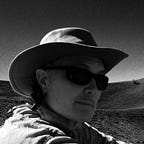Faceless
I don’t usually do this sort of thing. I tell anyone who’ll listen that my photography isn’t art, it’s just reporting, but that doesn’t mean I’m any sort of photojournalist or press photographer. What it usually means is that I’m mostly just a rather passive recorder of what’s happening around me, or of what I see in cities or landscapes as I walk or drive by, or of faces and bodies I know in one way or another. I don’t go out of my way to photograph events (unless I’m paid to, of course).
But this time it was an event — the 1991 People’s Park Riots — happening on my (then) home territory, Telegraph Avenue, Berkeley. And the riots and their aftermath affected me daily. I’ve told the full story (badly) elsewhere, but this wasn’t so much an event I could chose to go to or not, as a daily landscape, something that I could record (had to record) without becoming a photojournalist.
The rioters were mostly unseen, a shadowy presence much bigger in the media than in real life. But the protests, the protestors, and the resulting police were very visible — and very much the real story for a week or so. I had to get it — so I spent a few hours each day for a while taking photos just like a photojournalist. No one ever asked me what I was doing, or tried to stop me from taking photos, and I just stood around taking photos with my little Nikon FM2 35mm film camera with a fixed 28mm wide-angle lens. I seemed to have been basically invisible to all sides; I think it helped that I just acted like I knew what I was doing and wasn’t obviously just taking snaps or something; at one point the police herded me in with the other “real” photographers to a press conference. I would lie or kneel down in the road to get a shot, or — as with this one — walk right up the the police lines and crouch down and take a few quick shots looking up at the police. The news photographers from the Chron and the Trib basically took shots looking the other way (at the protestors) or of the rioters (who I never saw, at least when I had a camera with me); with a few exceptions, I didn’t really take shots from behind the police lines (even though the police always let me do so, often quite cheerfully). I had the advantage of being a local, with intimate knowledge of the streets and shops in the area.
This image was grabbed Saturday morning after a night of riots and during a lull in the protests, just before yet another round of rubber- and wooden-bullets were fired at the protestors (myself included). Everything surrounding this time was unstable — due to deliberate police tactics, we never knew which part of the street would suddenly be declared off-limits (and thus make you liable for arrest for being there, regardless of the fact that you might actually just be trying to get home), and the police were at that time over-reacting to almost any provocation, unintentional or not.
There’s a lot I like formally about this image, never mind the emotional or cultural associations: the overall dark black-and-white tone suits the atmosphere perfectly (and, in fact, it was one of those low-overcast glarey days so common during a Berkeley non-winter); the way the perspective emphasises how the police are rearing backwards; the particular moment caught when they’re almost surrounded by the (unseen) protestors and are looking in each direction to see what’s happening next; the reflections on the visors obscuring the faces; the V-sign over the shoulder of the nearest policeman; the unruly little tuft of hair escaping from under the helmet of the woman in the middle; the neat cursive script of the “Young” on the policeman’s uniform; the way they’re gripping the very phallic baton handles; the cheap plastic ballpoint pen in the CHP officer’s top pocket; the different textures of the uniforms; how small the woman police officer seems; and, basically, how human they and the situation really are under all the uniforms and equipment.
But for me it also works to evoke the feelings of what I came to call The Occupation — what it’s like to have an utterly faceless and somewhat unstable (and destabilising) police presence in your neighbourhood for a week or so, always asking you where you’re going, who you are, why you want to walk down your own street, or telling you that for some unknown (or just completely arbitrary) reason you can’t return to your friend’s place just yet. And what it’s like to have to answer to a bunch of anonymous out-of-town police who basically know nothing about your neighbourhood except what they’ve seen on TV or read in the morning’s papers, or (as is inevitable with Berkeley) what they “know” about Berkeley’s image. One of the (out-of-town) police chiefs involved in putting down the riots and protests commented that the protestors were “faceless out-of-towners” “hiding behind the mask of civil rights”. The irony…
And what were the riots and demonstrations all about? On the face of it, some volleyball courts being built in a ratty little park off Telegraph for UC Berkeley students. But there was more to it than that…
